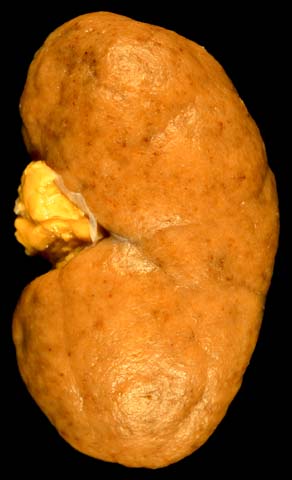Lupus nephritis
For patient information, click here
| Lupus nephritis | |
 | |
|---|---|
| Type IV lupus nephritis: The classic "flea-bitten" appearance of the cortical surface in the diffuse proliferative glomerulonephritides. (Courtesy of Ed Uthman, MD)]] | |
| ICD-10 | N08.5 |
| ICD-9 | 583.81 |
| MedlinePlus | 000481 |
| MeSH | D008181 |
Template:Search infobox Editor-In-Chief: C. Michael Gibson, M.S., M.D. [1]
Associate Editor-In-Chief: Cafer Zorkun, M.D., Ph.D. [2] Ujjwal Rastogi, MBBS [3]
Overview
Lupus nephritis is an inflammation of the kidney caused by systemic lupus erythematosus (SLE), a disease of the immune system. Apart from the kidneys, SLE can also damage the skin, joints, nervous system and virtually any organ or system in the body.
Signs and symptoms
Sufferers of lupus nephritis may or may not have symptoms of kidney disease, but it can manifest itself through weight gain, high blood pressure, darker foamy urine or swelling around the eyes, legs, ankles or fingers.
Furthermore, patients may suffer from other symptoms of lupus unrelated to kidney function. Such symptoms can include arthritis, fevers, gastro-intenstinal disturbances, headaches, fatigue, and fluid in the joints.
Diagnosis
The diagnosis of lupus nephritis depends on blood tests, urinalysis, X-rays, ultrasound scans of the kidneys, and a kidney biopsy. The World Health Organization has divided lupus nephritis into five classes based on the biopsy.
- Class I is histologically normal and does not show any evidence of disease.
- Class II is based on a finding of mesangial lupus nephritis. This form typically responds completely to treatment with corticosteroids.
- Class III is focal proliferative nephritis and often successfully responds to treatment with high doses of corticosteroids.
- Class IV is diffuse proliferative nephritis. This form is mainly treated with corticosteroids and immunosuppressant drugs.
- Class V is membranous nephritis and is characterized by extreme edema and protein loss.
- Class VI Glomerulosclerosis
Medicines which decrease swelling, lower blood pressure and decrease inflammation by suppressing the immune system. Patients may need to monitor intake of protein, sodium, and potassium. Patients with severe disease should restrict their sodium intake to 2 grams per day and limit fluid as well. Depending on the histology, renal function and degree of proteinuria, patients may require steroid therapy or chemotherapy regimens such as cyclophosphamide, azathioprine, mycophenolate mofetil or cyclosporine.
The medical therapy for lupus nephritis depends on the severity of the disease. For mild disease, corticosteroids are generally prescribed. More severe disease requires treatment with immunosuppressant agents. The two most commonly used agents are mycophenolate mofetil and intravenous cyclophosphamide. One recent study compared these two drugs.[1] The authors showed that patients with Class III or IV disease are more likely to benefit from mycophenolate mofetil as compared to cyclophosphamide. As a result, mycophenolate mofetil is now considered to be the first-line therapy for this disease.
References
- ↑ Ginzler EM, Dooley MA, Aranow C, Kim MY, et al. "Mycophenolate Mofetil or Intravenous Cyclophosphamide for Lupus Nephritis." New England Journal of Medicine. 353:21. 2219-2229. 24 November 2005.
External links
- Lupus Nephritis Clinical Research Study
- London Lupus Centre - Treatment, Diagnosis, Research
- Lupus Foundation of America, Inc.
- Lupus Research Institute
- S.L.E. Lupus Foundation
- Lupus International